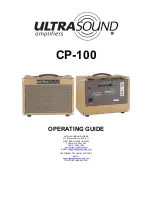
4.3. What is an EQ?
The equalizer allows you to cut or boost any frequency, or group of frequencies, within the
audio spectrum.
It was one of the first signal processing devices to enter a recording studio. Actually, even
the old domestic radios had some kind of EQ built-in. Usually, besides the control for the
volume, we also had a control for the Bass and another for the Treble. These Bass/Treble
EQs were also usual in Hi-Fi amplifiers.
Of course, in a studio the devices are more complex than that, and usually have more
controls. But in the beginning, they didn't have many of those, either.
Since the equalizer modeled in this plug-in is very old, it is one of those kind of simpler EQ
units, with just a control for Bass and another for Treble.
4.4. What does equalization do?
Equalization usually is used to correct a sound timbre and its harmonic balance. We can use
EQ, for example, to correct a particular sound in a mix, allowing it to “breathe” by boosting
the frequencies that are more important, and sometimes also by decrementing those same
frequencies in other instruments.
We may also use it as a creative tool, for example by manipulating the timbre of a certain
instrument to better match another one during overdubs, or (again) to better fit in the whole
mix.
We can finally use equalization to position an instrument in a three-dimensional stereo
image, increasing the separation between the different timbres.
Of course, this comes at a price, and the price is that every time we adjust frequencies we
create some phase shifting and discrepancies that may deteriorate the original sound.
It's up to us to balance the use of equalization in order to get a final result that sounds
good and musical. Like with almost everything, EQ must be used only when and where it’s
necessary.
20
Arturia - User Manual V76-Pre - V76-Pre OVERVIEW
Summary of Contents for V76-Pre
Page 1: ...USER MANUAL ...
















































